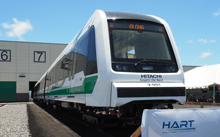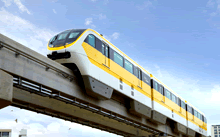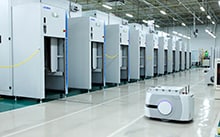Serving the Tokyo metropolitan area, the East Japan Railway Company, commonly known as “JR East,” implements an incredibly congested schedule of up to 10,000 trains per day, maintaining both on-time departures for all trains and safe & stable train operation. This rail transport is supported by ATOS (Autonomous decentralized Transport Operation control System), a system for the Tokyo metropolitan area developed by Hitachi through a collaborative creation project with JR East. The systemization of transport operation control work was long regarded as impractical. ATOS not only accomplishes this, it continues to evolve, delivering further improvements to safety & reliability and creating new customer services.
Japan's many visitors from abroad are amazed by the precise operation of Japan's railways. They are impressed by the always-on-time trains and speedy recoveries from schedule disruptions, despite a level of schedule congestion, exceptional even by global standards, for lines around in Tokyo and in its suburbs. Behind this accomplishment are systems referred to collectively as “Programed Traffic Control,” or “PTC.”
Operating 24 hours a day, 365 days a year, PTC provides the automatic control of rail signals, train intervals, and other railroading tasks while also automatically controlling station guide displays and voice announcements. In this way, PTC contributes to safe & comfortable train operation. Hitachi has conducted PTC development since the 1970s, boasting the top domestic market share in this field, as it supplies optimized systems to various railway companies.
One of these systems, called “ATOS” (Autonomous decentralized Transport Operation control System), has continuously evolved with the times. Until the start of the joint development project with JR East in February 1990, train traffic control depended on human resources. Station personnel would manually operate signals and railroad switches while such information as current train positions would be obtained through telephone communications with directors. Given this, only a fundamental revision and modernization of transport operation control work could attain needed enhancements to the safety & reliability of the exceedingly congested train service. The decision was therefore made to develop ATOS with such modernization goals as the complete automation of train route control and the systemization of the tracking of train operation status.

Train lines that have implemented constantly evolving ATOS
In 1990, computerized automatic signal control systems were already in use on other Japan Railway (JR) train lines. Numerous freight routes and complex traffic patterns, however, prevented their implementation for the highly congested Tokyo metro area train lines. Several other problems existed, including the need for a phased approach to the systemization of the wide-area metro region and the demand for expansion without service interruption to accommodate the 24-hour continuous operation system.
The solution was to adopt an autonomous decentralized system* as the basis for ATOS. ATOS would also differ significantly from other traffic control systems of the time in that its development would take advantage of cutting-edge information technology. This resulted in a comprehensive system that not only streamlines transport operation control work, but also retains such functionalities as detailed guidance for passengers and the management of maintenance work procedures.
ATOS was first introduced in 1996 on the JR East Chuo Line running between Tokyo and Kofu. Its implementation transformed conventional operation control work by incurring major changes, such as the shifting of operations carried out mainly at stations to a centralized control room. Other upsides for the Chuo Line were a 40-minute reduction in schedule disruption recovery time and the systemization of maintenance work procedures, a labor-saving measure for station personnel that eliminated this part of their workload.
As these widely ranging benefits gained recognition, the Yamanote, Keihin Tohoku, Sobu, and Tokaido lines have joined the increasing number of lines adopting this system, making ATOS synonymous with safe and stable transport.
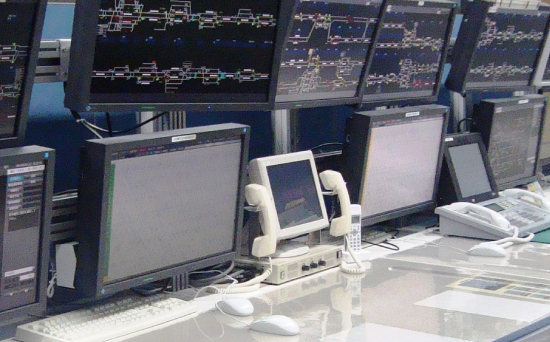
The updated transport command console; aiming to facilitate ease of use for command personnel, ATOS creates a display interface that streamlines transport operation control work.
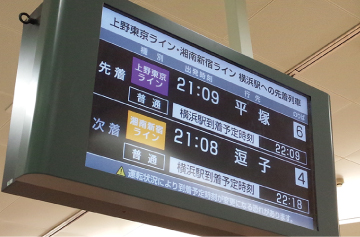
Guide displays located at train platforms provide notifications on scheduled arrival times and other pertinent information in real time from ATOS.
In conjunction with the growth of ATOS adoption, ATOS has continued to evolve by adding new functions. Although the initial development concept was the realization of safety & stability, recent years have seen a pressing need to build on this by responding to diversifying customer needs. Behind this trend are new requirements for cooperation between train lines arising from mutual track use and other such consequences of the ongoing diversification of transport. Command centers, station facilities, and software have been modified and improved as functional advances were made; but responding to new needs, as brought about by changes in the social environment, required a complete system overhaul.
Nearly 20 years after system launch, Hitachi embarked on a full-scale renovation. System structural optimization was achieved through upgrades to command centers, stations, and other facilities. Upgrading to a newly developed high-capacity, high-reliability network was carried out in order to handle wide-area traffic control, service expansion, and other initiatives. To improve the command environment, forecast scheduling was added. This is a feature for coping with the possible rippling of delays that works by ascertaining in advance future train delay situations and locations prone to the occurrence of problems.
System conversions began with the Chuo Line in March of 2014, which now enjoys the benefits of schedule disruption recovery time reduction and customer service enhancements. One example of such an enhancement is as follows: In March 2015, the Ueno-Tokyo Line began operations, giving passengers a choice between Omiya and Yokohama, a section already served by the Shonan-Shinjuku Line, by adding a route. Now, based on information from ATOS, the electronic noticeboards at the Omiya and Yokohama stations can display scheduled arrival times for both routes. Also new is the JR-EAST Train Info app for smartphones, which also makes use of information broadcast in real time by ATOS.
With the growth of safety & stability and customer needs, ATOS has also grown into an important part of the social infrastructure of the Tokyo metropolitan area. It has expanded to a current scale of operations consisting of 24 train lines and approximately 380 stations for a total expansion of about 1,300 km.
However, as the metro area rail transport network increasingly progresses, transport disturbances are expected to take on a broader range of effects. This will be seen in such events as disruptions on one line rippling onto multiple lines. At the same time, the rising complexity of transport command operations will create a demand for advances to transport command support functions achieved through technological innovation. Forecast scheduling was implemented in the full-scale renovation. Next up for considerations are further functional expansions that incorporate the accumulation and analysis of implementation schedule data, historical schedule data, and other such information.
Hitachi is committed to accelerating efforts toward enhancing the safety, stability, comfort, and convenience of railway systems as a comprehensive system integrator for railways through collaborative creation projects with JR East, while also taking into consideration the development of next-generation ATOS.
Release Date: October 2017
Solutions By: Hitachi, Ltd. Railway Systems Business Unit
